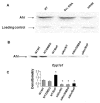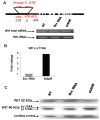AHR regulates WT1 genetic programming during murine nephrogenesis
- PMID: 21863216
- PMCID: PMC3321825
- DOI: 10.2119/molmed.2011.00125
AHR regulates WT1 genetic programming during murine nephrogenesis
Abstract
Mounting evidence suggests that the blueprint of chronic renal disease is established during early development by environmental cues that dictate alterations in differentiation programming. Here we show that aryl hydrocarbon receptor (AHR), a lig-and-activated basic helix-loop-helix-PAS homology domain transcription factor, disrupts murine renal differentiation by interfering with Wilms tumor suppressor gene (WT1) signaling in the developing kidney. Embryonic kidneys of C57BL/6J Ahr⁻/⁻ mice at gestation d (GD) 14 showed reduced condensation in the nephrogenic zone and decreased numbers of differentiated structures compared with wild-type mice. These deficits correlated with increased expression of the (+) 17aa Wt1 splice variant, decreased mRNA levels of Igf-1 rec., Wnt-4 and E-cadherin, and reduced levels of 52 kDa WT1 protein. AHR knockdown in wild-type embryonic kidney cells mimicked these alterations with notable increases in (+) 17aa Wt1 mRNA, reduced levels of 52 kDa WT1 protein, and increased (+) 17aa 40-kDa protein. AHR downregulation also reduced Igf-1 rec., Wnt-4, secreted frizzled receptor binding protein-1 (sfrbp-1) and E-cadherin mRNAs. In the case of Igf-1 rec. and Wnt-4, genetic disruption was fully reversed upon restoration of cellular Wt1 protein levels, confirming that functional interactions between AHR and Wt1 represent a likely molecular target for renal developmental interference.
Figures







Similar articles
-
A mutant Ahr allele protects the embryonic kidney from hydrocarbon-induced deficits in fetal programming.Environ Health Perspect. 2011 Dec;119(12):1745-53. doi: 10.1289/ehp.1103692. Epub 2011 Jul 29. Environ Health Perspect. 2011. PMID: 21803694 Free PMC article.
-
Ligand-activated Ahr signaling leads to disruption of nephrogenesis and altered Wilms' tumor suppressor mRNA splicing.Oncogene. 2003 Apr 10;22(14):2160-71. doi: 10.1038/sj.onc.1206238. Oncogene. 2003. PMID: 12687018
-
Genetic regulatory networks of nephrogenesis: deregulation of WT1 splicing by benzo(a)pyrene.Birth Defects Res C Embryo Today. 2009 Jun;87(2):192-7. doi: 10.1002/bdrc.20148. Birth Defects Res C Embryo Today. 2009. PMID: 19530133 Review.
-
A novel Wilms tumor 1 (WT1) target gene negatively regulates the WNT signaling pathway.J Biol Chem. 2010 May 7;285(19):14585-93. doi: 10.1074/jbc.M109.094334. Epub 2010 Mar 10. J Biol Chem. 2010. PMID: 20220130 Free PMC article.
-
Modulation of biological regulatory networks during nephrogenesis.Drug Metab Rev. 2006;38(4):677-83. doi: 10.1080/03602530600959532. Drug Metab Rev. 2006. PMID: 17145695 Review.
Cited by
-
Loss of S1P Lyase Expression in Human Podocytes Causes a Reduction in Nephrin Expression That Involves PKCδ Activation.Int J Mol Sci. 2023 Feb 7;24(4):3267. doi: 10.3390/ijms24043267. Int J Mol Sci. 2023. PMID: 36834691 Free PMC article.
-
Modulation of the Gut Microbiota by Resistant Starch as a Treatment of Chronic Kidney Diseases: Evidence of Efficacy and Mechanistic Insights.Adv Nutr. 2019 Mar 1;10(2):303-320. doi: 10.1093/advances/nmy068. Adv Nutr. 2019. PMID: 30668615 Free PMC article. Review.
-
The histone methyltransferase inhibitor BIX01294 enhances the cardiac potential of bone marrow cells.Stem Cells Dev. 2013 Feb 15;22(4):654-67. doi: 10.1089/scd.2012.0181. Epub 2012 Nov 7. Stem Cells Dev. 2013. PMID: 22994322 Free PMC article.
-
Podocyte injury caused by indoxyl sulfate, a uremic toxin and aryl-hydrocarbon receptor ligand.PLoS One. 2014 Sep 22;9(9):e108448. doi: 10.1371/journal.pone.0108448. eCollection 2014. PLoS One. 2014. PMID: 25244654 Free PMC article.
-
Aryl hydrocarbon receptor (AhR) reveals evidence of antagonistic pleiotropy in the regulation of the aging process.Cell Mol Life Sci. 2022 Aug 20;79(9):489. doi: 10.1007/s00018-022-04520-x. Cell Mol Life Sci. 2022. PMID: 35987825 Free PMC article. Review.
References
-
- Barker DJ, Winter PD, Osmond C, Margetts B, Simmonds SJ. Weight in infancy and death from ischaemic heart disease. Lancet. 1989;2:577–80. - PubMed
-
- Lim K, Armitage JA, Stefanidis A, Oldfield BJ, Black MJ. Intrauterine growth restriction in the absence of postnatal ‘catch-up’ growth leads to improved whole body insulin sensitivity in rat offspring. Pediatr Res 2011 - PubMed
-
- Nanez A, Ramos KS. Introduction and Overview of Receptor Systems. In: McQueen CA, editor. Comprehensive Toxicology. 2nd ed. Vol. 2. Elsevier; San Diego: 2010. pp. 71–80. editor in chief. Available at: http://www.knovel.com/web/portal/browse/display?_EXT_KNOVEL_DISPLAY_book....
-
- Falahatpisheh MH, Ramos KS. Ligand-activated Ahr signaling leads to disruption of nephrogenesis and altered Wilms’ tumor suppressor mRNA splicing. Oncogene. 2003;22:2160–71. - PubMed
Publication types
MeSH terms
Substances
Grants and funding
LinkOut - more resources
Full Text Sources
Molecular Biology Databases
Research Materials
Miscellaneous

